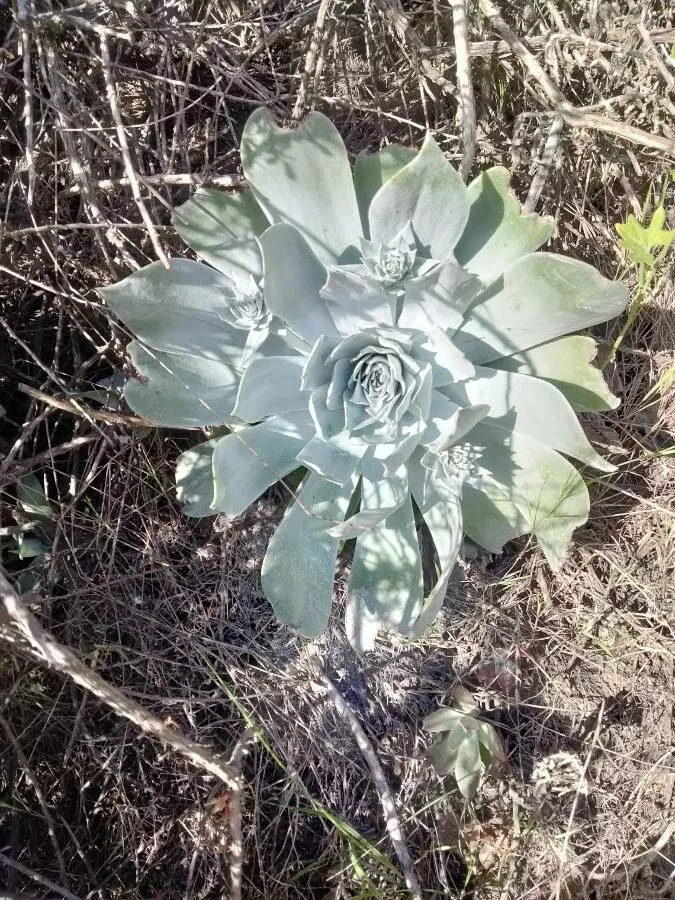
Author: (Nutt.) Britton & Rose
Bibliography: Bull. New York Bot. Gard. 3: 13 (1903)
Year: 1903
Status: accepted
Rank: species
Genus: Dudleya
Vegetable: False
Observations: S. California to Mexico (N. Baja California)
Chalk dudleya, scientifically known as Dudleya pulverulenta, is an intriguing and visually striking member of the Crassulaceae family. This succulent plant can be found primarily in Southern California, extending into Northern Baja California, Mexico. Its unique appearance and adaptability to its arid environment make it a fascinating subject for botany enthusiasts and gardeners alike.
This plant is known for its chalky, white to pale green rosette of leaves, which are covered in a fine, powdery coating. This characteristic ‘chalkiness’ not only gives the plant its common name but also serves as a natural sunscreen, protecting it from the harsh, direct sunlight of its native habitat. The thick, fleshy leaves are an adaptation that allows the plant to store water, crucial for survival in the dry, rocky areas where it naturally occurs.
During blooming season, the Chalk dudleya produces tall, slender stalks adorned with clusters of vibrant red to orange flowers. These blossoms are particularly appealing to hummingbirds and other pollinators, adding to the ecological dynamics of its native regions. The flowering period of Dudleya pulverulenta typically occurs from late spring to early summer, providing a splash of color and life to the otherwise stark landscapes it inhabits.
First described in 1903 in the Bulletin of the New York Botanical Garden by Britton and Rose, based on earlier work by Nuttall, Dudleya pulverulenta has since captivated the attention of botanists and plant collectors. Its aesthetic appeal, coupled with its rugged resilience, makes it a popular choice among succulents for cultivation in gardens that mimic its natural environment.
However, like many native plants, the Chalk dudleya faces threats from habitat destruction and climate change. Conservation efforts are essential to ensure that this unique species continues to thrive in its native regions. Growing them in gardens and controlled environments not only helps in conserving the species but also allows more people to appreciate its beauty and ecological role.
In conclusion, Dudleya pulverulenta, or Chalk dudleya, is more than just a plant; it is a remarkable example of nature’s ingenuity in adapting to challenging environments. Its distinct appearance and ecological contributions underscore the importance of preserving native plant species and the delicate balance of the ecosystems they inhabit.
Eng: chalk dudleya
Swe: silverrosett
En: Chalk dudleya, Chalk Live-forever, Chalk liveforever
Sv: Silverrosett
Taken Oct 7, 2022 by Elena Moses (cc-by-sa)
Taken Dec 1, 2022 by Josh (cc-by-sa)
Taken Mar 5, 2022 by Henry Broeska (cc-by-sa)
Taken Dec 18, 2021 by patricia fonseca (cc-by-sa)
Taken Mar 17, 2022 by Liz Pucket (cc-by-sa)
Taken Jun 3, 2022 by Henry Broeska (cc-by-sa)
© copyright of the Board of Trustees of the Royal Botanic Gardens, Kew.
Growth habit>: Forb/herb
Family: Myrtaceae Author: (F.Muell.) K.D.Hill & L.A.S.Johnson Bibliography: Telopea 6: 402 (1995) Year: 1995 Status:…
Family: Rubiaceae Author: Pierre ex A.Froehner Bibliography: Notizbl. Bot. Gart. Berlin-Dahlem 1: 237 (1897) Year:…
Family: Sapindaceae Author: Koidz. Bibliography: J. Coll. Sci. Imp. Univ. Tokyo 32(1): 38 (1911) Year:…
Family: Asteraceae Author: A.Gray Bibliography: Pacif. Railr. Rep.: 107 (1857) Year: 1857 Status: accepted Rank:…
Family: Fabaceae Author: Medik. Bibliography: Vorles. Churpfälz. Phys.-Ökon. Ges. 2: 398 (1787) Year: 1787 Status:…
Family: Aspleniaceae Author: (Cav.) Alston Bibliography: Bull. Misc. Inform. Kew 1932: 309 (1932) Year: 1932…